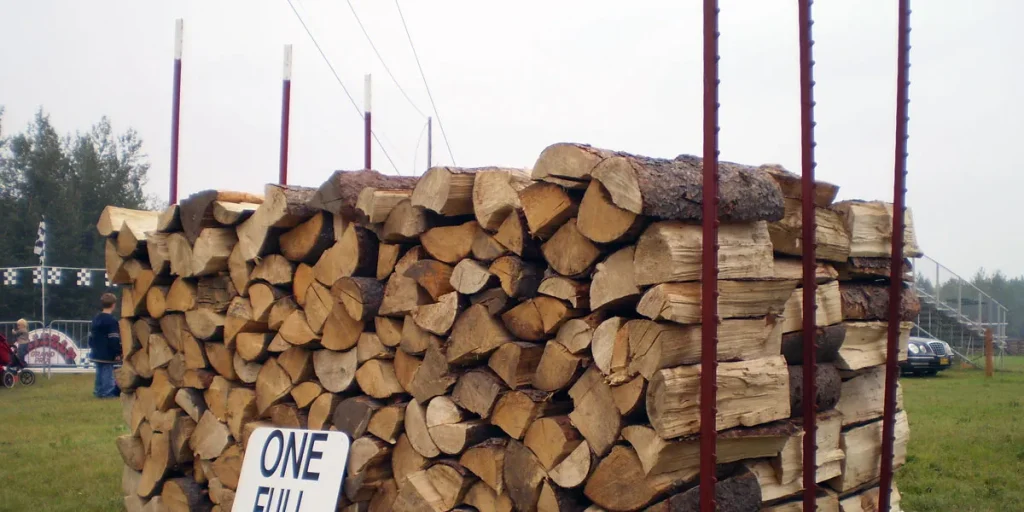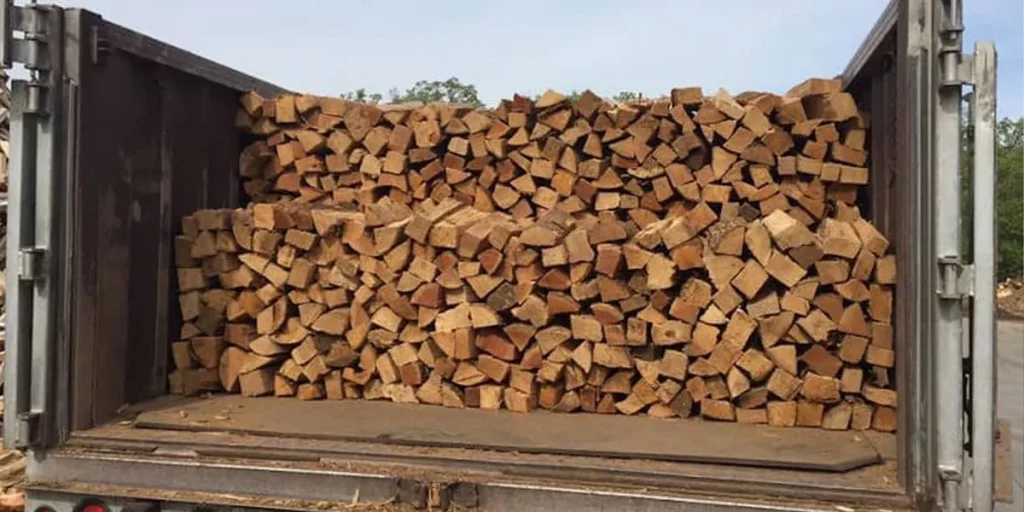A cord of wood typically weighs around 4,000 to 5,000 pounds. The exact weight depends on wood type and moisture content.
Understanding the weight of a cord of wood is crucial for those looking to purchase firewood for their home heating needs.
This measurement of wood quantity, which is 128 cubic feet, is essential for consumers to make informed decisions.
The type of wood, whether it’s hardwood or softwood, greatly influences the overall weight.
Seasoned wood, which is dried and has less moisture, will weigh less than green wood, fresh cut with higher moisture content.
Accurate knowledge of the weight helps in proper storage and transportation planning. Safe handling guidelines for transporting and stacking a cord of wood also rely on its weight.
As fuel consumption and heating efficiency depend on wood type and weight, this information is invaluable for wood stove and fireplace users.

Basics Of Firewood Measurement
Understanding how firewood is measured is key before you buy or sell. Measuring firewood ensures you get what you pay for.
Cord Defined: Volume Vs. Weight
A cord is a unit of measure for firewood. This term confuses many because it combines volume and weight.
Know that a cord represents a stack of wood rather than its heaviness.
- Volume: A cord reflects space the wood occupies.
- Weight: It varies based on wood type and moisture.
Since woods like oak are denser, they weigh more than something like pine. Moist wood also weighs more than dry. This is crucial to remember when considering a cord.
Standard Dimensions Of A Full Cord
A full cord usually has standard dimensions. This makes it easier to picture the amount of firewood you’re dealing with. A full cord typically measures:
| Length (feet) | Width (feet) | Height (feet) | Volume (cubic feet) |
|---|---|---|---|
| 8 | 4 | 4 | 128 |
This size is equal to a well-stacked pile of wood 8 feet long, 4 feet wide, and 4 feet tall. Ensure you receive the correct volume when purchasing a cord of wood.
Types Of Wood And Their Impact On Weight

Understanding how wood types affect weight is crucial when buying firewood. Different woods can vary significantly in their weight.
This variation affects how much heat they produce and their burn time. In this section, we dive into the differences between hardwood and softwood.
We also look at common firewood species and their specific weights.
Hardwood Vs. Softwood: Weight Differences
Wood is generally classified into two groups: hardwood and softwood. This classification is not based on the wood’s actual hardness, but rather the type of tree it comes from.
Hardwood comes from deciduous trees which shed leaves annually. Softwood comes from conifers, which usually remain evergreen.
- Hardwoods, like oak and maple, are typically heavier. They offer a higher density, which means they burn longer and produce more heat.
- Softwoods, such as pine and fir, are lighter. They catch fire easily but burn faster with a quick, hot flame.
Common Firewood Species And Their Weights
The weight of a cord of wood varies depending on the species. Below is a table that outlines the approximate weight of a full cord of some common types of firewood when they are seasoned:
| Species | Weight (lbs) |
|---|---|
| Oak | 3,200 – 3,900 |
| Maple | 2,600 – 3,200 |
| Birch | 2,500 – 3,100 |
| Pine | 1,300 – 1,600 |
| Fir | 1,200 – 1,900 |
Remember, these weights are for seasoned wood, which means the wood has been dried and has less moisture.
Freshly cut wood weighs more because of the higher water content.
Factors Influencing The Weight Of A Cord

Understanding the factors influencing the weight of a cord of wood is crucial for buyers and sellers alike.
A cord is a standardized measurement of wood, representing a stack that is 4 feet high, 4 feet wide, and 8 feet long.
The weight can vary significantly based on several variables. Let’s dive into the key factors that dictate how much a cord of wood weighs.
Moisture Content And Its Effects
The amount of water retained in wood profoundly affects its weight. Here’s how moisture levels play a role:
- Green Wood: Newly cut wood contains a high amount of water, making it extremely heavy.
- Air-Dried Wood: When wood is exposed to air, it begins to lose moisture and hence weight.
- Kiln-Dried Wood: Wood dried in a kiln loses more moisture than air-dried wood, resulting in a lighter cord.
In general, the drier the wood, the lighter it is. For example, a cord of green wood can weigh up to twice as much as the same volume of dry wood.
Seasoning Duration And Weight Reduction
The length of time wood is left to dry, or ‘season’, impacts its weight. Consider the following points:
- Short-Term Seasoning: Wood loses water quickly at first, but not all moisture evaporates.
- Long-Term Seasoning: Over several months, wood reaches a more stable, lower weight.
Taking the time to properly season wood maximizes its fuel efficiency and minimizes its weight. Ideal seasoning time can vary, but a minimum of six months is often recommended.
When purchasing wood, it’s important to ask about moisture content and seasoning time to ensure you receive a fair volume for the weight you handle.
Understanding these two primary factors will help you make an informed decision and select wood that best suits your needs.
Estimating The Heft Of A Cord
Welcome to your guide on estimating the heft of a cord of wood. A cord is a large amount of wood. It is important for buyers and sellers.
Knowing the weight helps with delivery and usage plans.
Average Weights Of A Cord By Wood Type
Different types of wood have different weights. Wood type affects how much a cord weighs. Each type has an average weight. Here’s a quick look:
| Wood Type | Weight (lbs) |
|---|---|
| Oak | 3750-5000 |
| Pine | 2500-3500 |
| Maple | 3200-4000 |
| Birch | 3000-3900 |
| Fir | 2100-2600 |
Calculating The Weight: Practical Tips
Estimating a cord’s weight is easy if you follow these tips:
- Know the wood type: Reference the table above.
- Use a scale: For smaller amounts, weigh them. Then, multiply for a full cord.
- Consider moisture: Wet wood weighs more than dry wood.
- Learn the average density: Harder woods are heavier.
Remember, these weights are estimates. Actual weight can vary. Use these tips as a guide when planning.
Handling And Transporting A Cord Of Wood
If you’ve recently purchased a cord of wood, you might be wondering about the best way to transport and handle it.
Considering a full cord of wood can weigh upwards of 5,000 pounds depending on wood type and moisture content, moving it is no small task!
Below are essential tips for safely managing this hefty load.
Safety Considerations For Lifting And Moving
Moving a cord of wood safely is crucial to avoid injuries. Here are the key points to remember:
- Wear protective gear. This includes gloves and supportive footwear.
- Lift correctly. Always bend at the knees and keep the back straight.
- Get help. A cord of wood is too heavy for one person. Work with at least one other person.
- Clear the path. Ensure the route from the woodpile to the vehicle is free of obstacles.
Equipment For Transporting Heavy Cords
The right equipment is essential for moving a cord of wood. Consider the following:
| Equipment Type | Usage |
|---|---|
| Wheelbarrow or Cart | Best for small distances and uneven terrain. |
| Dolly or Hand Truck | Ideal for moving multiple logs at once on flat surfaces. |
| Pickup Truck or Trailer | Required for transporting a full cord over longer distances. |
| Straps and Tarps | Used to secure the load during transport and protect it from the elements. |
Always check equipment capacity to ensure it can handle the weight of the wood. Proper use of this equipment can prevent damage to the wood and injury to yourself or others.
FAQs About the Weight of a Cord of Wood
What Is The Weight Of A Full Cord Of Wood?
A full cord of wood typically weighs between 2,500 to 3,500 pounds. This range can vary based on the type of wood and its moisture content.
How Does Wood Type Affect Cord Weight?
The weight of a cord of wood can vary greatly depending on wood type. Hardwoods like oak are denser and therefore heavier, while softwoods such as pine are lighter.
What Size Is A Standard Cord Of Wood?
A standard cord of wood measures 128 cubic feet, usually stacked as 4 feet high, 4 feet deep, and 8 feet long. These dimensions may vary if the wood is not tightly stacked.
Can Cord Wood Weight Differ Seasonally?
Yes, cord wood weight differs seasonally. Wood holds more moisture and is heavier when fresh-cut or in wet seasons, and lighter when seasoned or dry.
Conclusion
Wrapping up, understanding the weight of a cord of wood is crucial for both buyers and sellers. It aids in ensuring fair transactions and proper storage.
Remember, a full cord typically weighs between 2,000 and 3,000 pounds, though this varies with wood type and moisture content.
Armed with this knowledge, you’re set for a warm, well-stocked season.
Resources:
https://www.fs.usda.gov/Internet/FSE_DOCUMENTS/stelprdb5328581.pdf
https://www.evansvillegov.org/egov/documents/1499654482_36259.pdf
